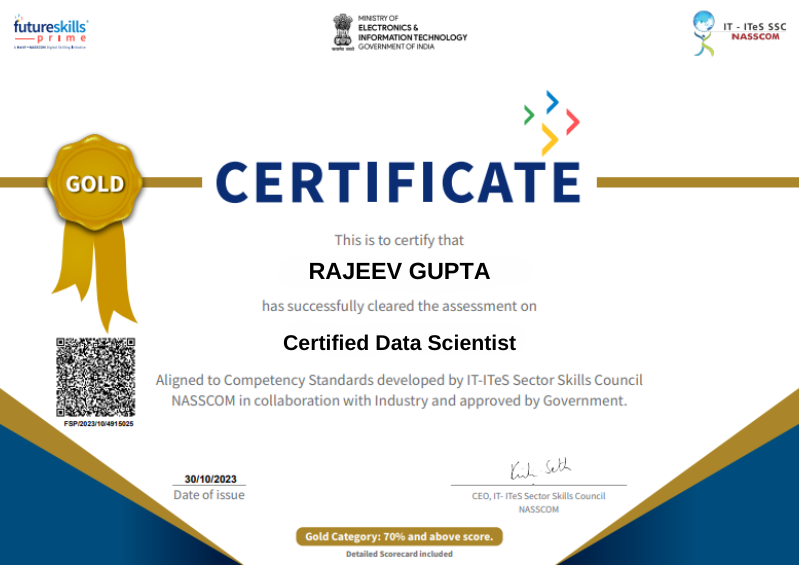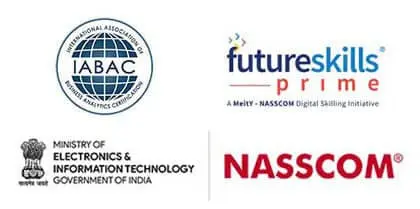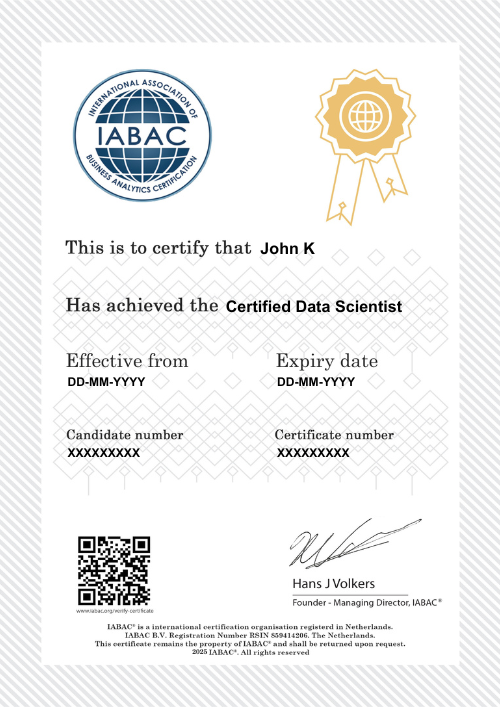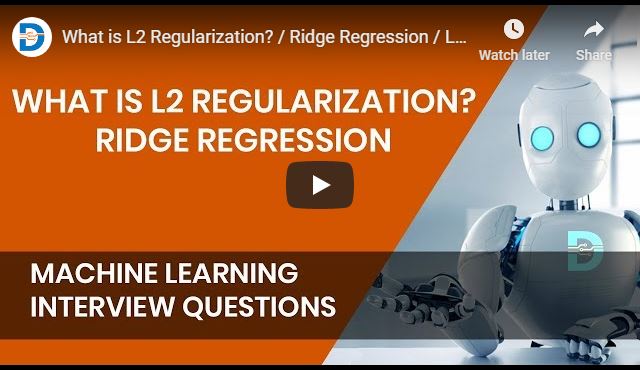Instructor Led Live Online
Self Learning + Live Mentoring
In - Person Classroom Training




MODULE 1: DATA SCIENCE ESSENTIALS
• Introduction to Data Science
• Evolution of Data Science
• Big Data Vs Data Science
• Data Science Terminologies
• Data Science vs AI/Machine Learning
• Data Science vs Analytics
MODULE 2: DATA SCIENCE DEMO
• Business Requirement: Use Case
• Data Preparation
• Machine learning Model building
• Prediction with ML model
• Delivering Business Value.
MODULE 3: ANALYTICS CLASSIFICATION
• Types of Analytics
• Descriptive Analytics
• Diagnostic Analytics
• Predictive Analytics
• Prescriptive Analytics
• EDA and insight gathering demo in Tableau
MODULE 4: DATA SCIENCE AND RELATED FIELDS
• Introduction to AI
• Introduction to Computer Vision
• Introduction to Natural Language Processing
• Introduction to Reinforcement Learning
• Introduction to GAN
• Introduction to Generative Passive Models
MODULE 5: DATA SCIENCE ROLES & WORKFLOW
• Data Science Project workflow
• Roles: Data Engineer, Data Scientist, ML Engineer and MLOps Engineer
• Data Science Project stages.
MODULE 6: MACHINE LEARNING INTRODUCTION
• What Is ML? ML Vs AI
• ML Workflow, Popular ML Algorithms
• Clustering, Classification And Regression
• Supervised Vs Unsupervised
MODULE 7: DATA SCIENCE INDUSTRY APPLICATIONS
• Data Science in Finance and Banking
• Data Science in Retail
• Data Science in Health Care
• Data Science in Logistics and Supply Chain
• Data Science in Technology Industry
• Data Science in Manufacturing
• Data Science in Agriculture
MODULE 1: PYTHON BASICS
• Introduction of python
• Installation of Python and IDE
• Python Variables
• Python basic data types
• Number & Booleans, strings
• Arithmetic Operators
• Comparison Operators
• Assignment Operators
MODULE 2: PYTHON CONTROL STATEMENTS
• IF Conditional statement
• IF-ELSE
• NESTED IF
• Python Loops basics
• WHILE Statement
• FOR statements
• BREAK and CONTINUE statements
MODULE 3: PYTHON DATA STRUCTURES
• Basic data structure in python
• Basics of List
• List: Object, methods
• Tuple: Object, methods
• Sets: Object, methods
• Dictionary: Object, methods
MODULE 4: PYTHON FUNCTIONS
• Functions basics
• Function Parameter passing
• Lambda functions
• Map, reduce, filter functions
MODULE 1: OVERVIEW OF STATISTICS
• Introduction to Statistics
• Descriptive And Inferential Statistics
• Basic Terms Of Statistics
• Types Of Data
MODULE 2: HARNESSING DATA
• Random Sampling
• Sampling With Replacement And Without Replacement
• Cochran's Minimum Sample Size
• Types of Sampling
• Simple Random Sampling
• Stratified Random Sampling
• Cluster Random Sampling
• Systematic Random Sampling
• Multi stage Sampling
• Sampling Error
• Methods Of Collecting Data
MODULE 3: EXPLORATORY DATA ANALYSIS
• Exploratory Data Analysis Introduction
• Measures Of Central Tendencies: Mean,Median And Mode
• Measures Of Central Tendencies: Range, Variance And Standard Deviation
• Data Distribution Plot: Histogram
• Normal Distribution & Properties
• Z Value / Standard Value
• Empirical Rule and Outliers
• Central Limit Theorem
• Normality Testing
• Skewness & Kurtosis
• Measures Of Distance: Euclidean, Manhattan And Minkowski Distance
• Covariance & Correlation
MODULE 4: HYPOTHESIS TESTING
• Hypothesis Testing Introduction
• P- Value, Critical Region
• Types of Hypothesis Testing
• Hypothesis Testing Errors : Type I And Type II
• Two Sample Independent T-test
• Two Sample Relation T-test
• One Way Anova Test
• Application of Hypothesis testing
MODULE 1: MACHINE LEARNING INTRODUCTION
• What Is ML? ML Vs AI
• Clustering, Classification And Regression
• Supervised Vs Unsupervised
MODULE 2: PYTHON NUMPY PACKAGE
• Introduction to Numpy Package
• Array as Data Structure
• Core Numpy functions
• Matrix Operations, Broadcasting in Arrays
MODULE 3: PYTHON PANDAS PACKAGE
• Introduction to Pandas package
• Series in Pandas
• Data Frame in Pandas
• File Reading in Pandas
• Data munging with Pandas
MODULE 4: VISUALIZATION WITH PYTHON - Matplotlib
• Visualization Packages (Matplotlib)
• Components Of A Plot, Sub-Plots
• Basic Plots: Line, Bar, Pie, Scatter
MODULE 5: PYTHON VISUALIZATION PACKAGE - SEABORN
• Seaborn: Basic Plot
• Advanced Python Data Visualizations
MODULE 6: ML ALGO: LINEAR REGRESSSION
• Introduction to Linear Regression
• How it works: Regression and Best Fit Line
• Modeling and Evaluation in Python
MODULE 7: ML ALGO: LOGISTIC REGRESSION
• Introduction to Logistic Regression
• How it works: Classification & Sigmoid Curve
• Modeling and Evaluation in Python
MODULE 8: ML ALGO: K MEANS CLUSTERING
• Understanding Clustering (Unsupervised)
• K Means Algorithm
• How it works : K Means theory
• Modeling in Python
MODULE 9: ML ALGO: KNN
• Introduction to KNN
• How It Works: Nearest Neighbor Concept
• Modeling and Evaluation in Python
MODULE 1: FEATURE ENGINEERING
• Introduction to Feature Engineering
• Feature Engineering Techniques: Encoding, Scaling, Data Transformation
• Handling Missing values, handling outliers
• Creation of Pipeline
• Use case for feature engineering
MODULE 2: ML ALGO: SUPPORT VECTOR MACHINE (SVM)
• Introduction to SVM
• How It Works: SVM Concept, Kernel Trick
• Modeling and Evaluation of SVM in Python
MODULE 3: PRINCIPAL COMPONENT ANALYSIS (PCA)
• Building Blocks Of PCA
• How it works: Finding Principal Components
• Modeling PCA in Python
MODULE 4: ML ALGO: DECISION TREE
• Introduction to Decision Tree & Random Forest
• How it works
• Modeling and Evaluation in Python
MODULE 5: ENSEMBLE TECHNIQUES - BAGGING
• Introduction to Ensemble technique
• Bagging and How it works
• Modeling and Evaluation in Python
MODULE 6: ML ALGO: NAÏVE BAYES
• Introduction to Naive Bayes
• How it works: Bayes' Theorem
• Naive Bayes For Text Classification
• Modeling and Evaluation in Python
MODULE 7: GRADIENT BOOSTING, XGBOOST
• Introduction to Boosting and XGBoost
• How it works?
• Modeling and Evaluation of in Python
MODULE 1: TIME SERIES FORECASTING - ARIMA
• What is Time Series?
• Trend, Seasonality, cyclical and random
• Stationarity of Time Series
• Autoregressive Model (AR)
• Moving Average Model (MA)
• ARIMA Model
• Autocorrelation and AIC
• Time Series Analysis in Python
MODULE 2: SENTIMENT ANALYSIS
• Introduction to Sentiment Analysis
• NLTK Package
• Case study: Sentiment Analysis on Movie Reviews
MODULE 3: REGULAR EXPRESSIONS WITH PYTHON
• Regex Introduction
• Regex codes
• Text extraction with Python Regex
MODULE 4: ML MODEL DEPLOYMENT WITH FLASK
• Introduction to Flask
• URL and App routing
• Flask application – ML Model deployment
MODULE 5: ADVANCED DATA ANALYSIS WITH MS EXCEL
• MS Excel core Functions
• Advanced Functions (VLOOKUP, INDIRECT..)
• Linear Regression with EXCEL
• Data Table
• Goal Seek Analysis
• Pivot Table
• Solving Data Equation with EXCEL
MODULE 6: AWS CLOUD FOR DATA SCIENCE
• Introduction of cloud
• Difference between GCC, Azure, AWS
• AWS Service ( EC2 instance)
MODULE 7: AZURE FOR DATA SCIENCE
• Introduction to AZURE ML studio
• Data Pipeline
• ML modeling with Azure
MODULE 8: INTRODUCTION TO DEEP LEARNING
• Introduction to Artificial Neural Network, Architecture
• Artificial Neural Network in Python
• Introduction to Convolutional Neural Network, Architecture
• Convolutional Neural Network in Python
MODULE 1: DATABASE INTRODUCTION
• DATABASE Overview
• Key concepts of database management
• Relational Database Management System
• CRUD operations
MODULE 2: SQL BASICS
• Introduction to Databases
• Introduction to SQL
• SQL Commands
• MY SQL workbench installation
MODULE 3: DATA TYPES AND CONSTRAINTS
• Numeric, Character, date time data type
• Primary key, Foreign key, Not null
• Unique, Check, default, Auto increment
MODULE 4: DATABASES AND TABLES (MySQL)
• Create database
• Delete database
• Show and use databases
• Create table, Rename table
• Delete table, Delete table records
• Create new table from existing data types
• Insert into, Update records
• Alter table
MODULE 5: SQL JOINS
• Inner Join, Outer Join
• Left Join, Right Join
• Self Join, Cross join
• Windows function: Over, Partition, Rank
MODULE 6: SQL COMMANDS AND CLAUSES
• Select, Select distinct
• Aliases, Where clause
• Relational operators, Logical
• Between, Order by, In
• Like, Limit, null/not null, group by
• Having, Sub queries
MODULE 7 : DOCUMENT DB/NO-SQL DB
• Introduction of Document DB
• Document DB vs SQL DB
• Popular Document DBs
• MongoDB basics
• Data format and Key methods
MODULE 1: GIT INTRODUCTION
• Purpose of Version Control
• Popular Version control tools
• Git Distribution Version Control
• Terminologies
• Git Workflow
• Git Architecture
MODULE 2: GIT REPOSITORY and GitHub
• Git Repo Introduction
• Create New Repo with Init command
• Git Essentials: Copy & User Setup
• Mastering Git and GitHub
MODULE 3: COMMITS, PULL, FETCH AND PUSH
• Code Commits
• Pull, Fetch and Conflicts resolution
• Pushing to Remote Repo
MODULE 4: TAGGING, BRANCHING AND MERGING
• Organize code with branches
• Checkout branch
• Merge branches
• Editing Commits
• Commit command Amend flag
• Git reset and revert
MODULE 5: GIT WITH GITHUB AND BITBUCKET
• Creating GitHub Account
• Local and Remote Repo
• Collaborating with other developers
MODULE 1: BIG DATA INTRODUCTION
• Big Data Overview
• Five Vs of Big Data
• What is Big Data and Hadoop
• Introduction to Hadoop
• Components of Hadoop Ecosystem
• Big Data Analytics Introduction
MODULE 2 : HDFS AND MAP REDUCE
• HDFS – Big Data Storage
• Distributed Processing with Map Reduce
• Mapping and reducing stages concepts
• Key Terms: Output Format, Partitioners,
• Combiners, Shuffle, and Sort
MODULE 3: PYSPARK FOUNDATION
• PySpark Introduction
• Spark Configuration
• Resilient distributed datasets (RDD)
• Working with RDDs in PySpark
• Aggregating Data with Pair RDDs
MODULE 4: SPARK SQL and HADOOP HIVE
• Introducing Spark SQL
• Spark SQL vs Hadoop Hive
MODULE 1: TABLEAU FUNDAMENTALS
• Introduction to Business Intelligence & Introduction to Tableau
• Interface Tour, Data visualization: Pie chart, Column chart, Bar chart.
• Bar chart, Tree Map, Line Chart
• Area chart, Combination Charts, Map
• Dashboards creation, Quick Filters
• Create Table Calculations
• Create Calculated Fields
• Create Custom Hierarchies
MODULE 2: POWER-BI BASICS
• Power BI Introduction
• Basics Visualizations
• Dashboard Creation
• Basic Data Cleaning
• Basic DAX FUNCTION
MODULE 3 : DATA TRANSFORMATION TECHNIQUES
• Exploring Query Editor
• Data Cleansing and Manipulation:
• Creating Our Initial Project File
• Connecting to Our Data Source
• Editing Rows
• Changing Data Types
• Replacing Values
MODULE 4: CONNECTING TO VARIOUS DATA SOURCES
• Connecting to a CSV File
• Connecting to a Webpage
• Extracting Characters
• Splitting and Merging Columns
• Creating Conditional Columns
• Creating Columns from Examples
• Create Data Model
A Certified Data Scientist program is a structured certification that equips individuals with skills in data analysis, machine learning, and statistical modeling. It validates proficiency in handling complex data tasks and applying analytical techniques to real-world challenges. Completing such a program can improve career opportunities in the data science field.
Data science relies on tools like Python and R for coding, with libraries such as Pandas and NumPy for data manipulation. Visualization is often done with Matplotlib and Tableau. For machine learning, frameworks such as TensorFlow and Scikit-learn are commonly used.
Yes, learning Python is highly recommended for a Data Science course. It offers powerful libraries for data analysis, machine learning, and visualization. Having Python skills will make it easier to work with real-world datasets.
Several well-known companies in Mumbai are hiring data scientists. Infosys and Tech Mahindra are expanding their data-driven services. Persistent Systems focuses on digital transformation projects. IBM is actively recruiting for data scientist roles, and many finance and media firms in Mumbai are also seeking talent.
Statistical analysis is essential in data science because it helps uncover patterns, trends, and relationships in data. It provides a solid foundation for predictions and insights. Without it, data-driven conclusions may lack reliability.
Yes, a non-engineering graduate can build a career in data science by gaining skills in programming, statistics, and machine learning. Many professionals transition from other fields by taking online courses, certifications, and practical projects. Strong analytical thinking and problem-solving abilities are key to success.
Data science relies on statistical analysis, machine learning, and data visualization to extract insights. It uses data cleaning, feature engineering, and predictive modeling to improve accuracy. Techniques like clustering, regression, and neural networks help uncover patterns and trends.
To become a data scientist in Mumbai, start by building strong skills in programming, statistics, and machine learning through courses or self-study. Gain practical experience with real-world projects and internships to strengthen expertise. Networking with professionals, attending local meetups, and applying for relevant jobs will help you break into the field.
Mumbai continues to see strong demand for data science professionals, with over 2,000 job listings on platforms like Indeed. The city's diverse industries, including IT, finance, media, and healthcare, are increasingly seeking data expertise to drive decision-making and innovation. This trend reinforces Mumbai’s position as a hub for data science careers.
Yes, freshers can join a data science course in Andheri East and build the necessary skills. Many institutes offer job assistance, which increases the chances of securing a role. Success depends on learning, projects, and staying updated with industry trends.
To enroll in a data science course in Andheri East, you should have basic programming knowledge, preferably in Python or R. A strong foundation in mathematics, including statistics and linear algebra, is essential. Analytical thinking and problem-solving skills will help you understand and apply data science concepts effectively.
Mumbai has several job openings for data science freshers in roles like data analyst, machine learning engineer, and junior data scientist. Many companies seek candidates with strong analytical skills, Python, and SQL knowledge. Checking job portals and company websites regularly helps in finding suitable opportunities.
According to Glassdoor, data scientists in Mumbai with one year of experience earn an average annual salary of ₹15 lakhs, typically ranging from ₹4 lakhs to ₹25 lakhs. Entry-level salaries may differ based on factors like education, technical expertise, and the company's size and industry. Researching specific organizations and roles gives a clearer picture of potential earnings.
Yes, DataMites offers offline data science courses at DataMites Andheri East branch, located at 10th Floor, Crescent Plaza, Teli Gali, Bima Nagar, Andheri East, Mumbai, Maharashtra 400053. This location is convenient for learners coming from nearby areas such as Gundavali (400069), Chakala (400093), Bima Nagar (400069), Junaid Nagar (400058), Dhangar Wadi (400058), Amboli (400058), Andheri (400058), Natwar Nagar (400060), Marol (400059), Powai (400076), Koldongri (400069), Parshiwada (400099), Paranjape Nagar (400057), Jogeshwari (400102), and Vahatuk Nagar (400047). The institute provides comprehensive training with practical, hands-on applications for those looking to build a strong career in data science.
There are many institutes in Andheri East for data science, but DataMites is one of the best. It offers industry-relevant training with hands-on projects and expert guidance. The institute also provides flexible learning options to help students build strong data science skills.
The Data Science course at the Andheri East branch is open to students, working professionals, and anyone interested in building expertise in data analysis and machine learning. There are no strict prerequisites, though basic programming and math skills are helpful. Enrollment is based on course availability and eligibility criteria set by the institute.
A data science course in Andheri East offers hands-on training with real-world projects, enhancing practical skills. It provides access to industry experts and networking opportunities, which helps with career growth. The course equips learners with in-demand tools and techniques, improving job prospects.
Anyone with a basic understanding of mathematics, statistics, and programming can join a data science course. No specific degree is required, but a background in computer science, engineering, or economics can be useful. Enthusiasts looking to gain analytical skills can also pursue the course.
The duration of data science courses in Andheri East typically ranges from 3 months to 1 year. Short-term programs focus on fundamentals, while longer courses provide in-depth learning. The timeframe depends on the course structure and learning mode.
Yes. If you miss a class, you’ll have access to the recorded session. Since all sessions are recorded, you can review them anytime and keep up with the coursework without falling behind.
Training at DataMites is headed by Ashok Veda, CEO of Rubixe, supported by a team of experienced professionals with strong industry backgrounds and relevant certifications. They bring hands-on expertise to ensure the learning is current and practical.
At DataMites Mumbai, access to online study materials usually lasts between 6 months and 1 year, depending on the course you choose. This gives you enough time to work through the lessons at a pace that suits your schedule.
At the Andheri East branch, you can request a full refund within one week of the batch starting, provided you’ve attended no more than two classes. To request a refund, email care@datamites.com from your registered email. Refunds aren’t available after six months.
DataMites operates one offline training center in Mumbai:
Enrolled students gain access to a wide set of resources, including textbooks, reference material, practice datasets, and recorded class sessions. You’ll also work on projects, get continuous mentor support, and learn industry-relevant tools and techniques.
Once you finish the course, you’ll receive certifications from IABAC® (International Association of Business Analytics Certification) and NASSCOM® FutureSkills. These are industry-recognized and add strong value to your professional profile.
The Data Science course at DataMites Andheri East is built around practical training and exposure to real-world problems. You’ll learn from expert instructors, use updated learning resources, and gain the skills needed to thrive in the data science industry.
Yes, internships are part of the Data Science courses. Students get to work on real-world projects guided by industry professionals. After completion, they receive both an internship certificate and an experience letter from DataMites.
Yes, courses at DataMites Andheri East include live projects. The Certified Data Scientist course features 25 capstone projects and one client project. The Diploma in Data Science includes five capstone projects and one client project, giving students plenty of hands-on practice.
Yes, DataMites Andheri East offers an EMI option for DataMites Data Science courses, making it easier for students to pay their fees over time. This flexible plan helps reduce the financial load. For complete details, it’s best to contact the team directly.
Yes, DataMites Andheri East provides placement assistance. This includes training, certifications, resume building, and interview prep. While they help you with the right tools and guidance, securing a job ultimately depends on your performance and opportunities available.
Data Science course fees in Mumbai typically range from ?15,000 to ?2,50,000. At the DataMites Andheri East branch, the fees for various courses are between ?40,000 and ?1,20,000. The Certified Data Scientist Program, which runs for 8 months, costs ?59,451 for online, ?64,451 for offline, and ?34,951 for blended learning. Other programs like the Data Science Foundation and Data Science for Managers start at ?24,000.
To enroll, visit the official DataMites website and fill out the registration form. You can also connect with the Andheri East center for step-by-step guidance on the process. Make sure you meet the course prerequisites before applying.
The DataMites Placement Assistance Team(PAT) facilitates the aspirants in taking all the necessary steps in starting their career in Data Science. Some of the services provided by PAT are: -
The DataMites Placement Assistance Team(PAT) conducts sessions on career mentoring for the aspirants with a view of helping them realize the purpose they have to serve when they step into the corporate world. The students are guided by industry experts about the various possibilities in the Data Science career, this will help the aspirants to draw a clear picture of the career options available. Also, they will be made knowledgeable about the various obstacles they are likely to face as a fresher in the field, and how they can tackle.
No, PAT does not promise a job, but it helps the aspirants to build the required potential needed in landing a career. The aspirants can capitalize on the acquired skills, in the long run, to a successful career in Data Science.










